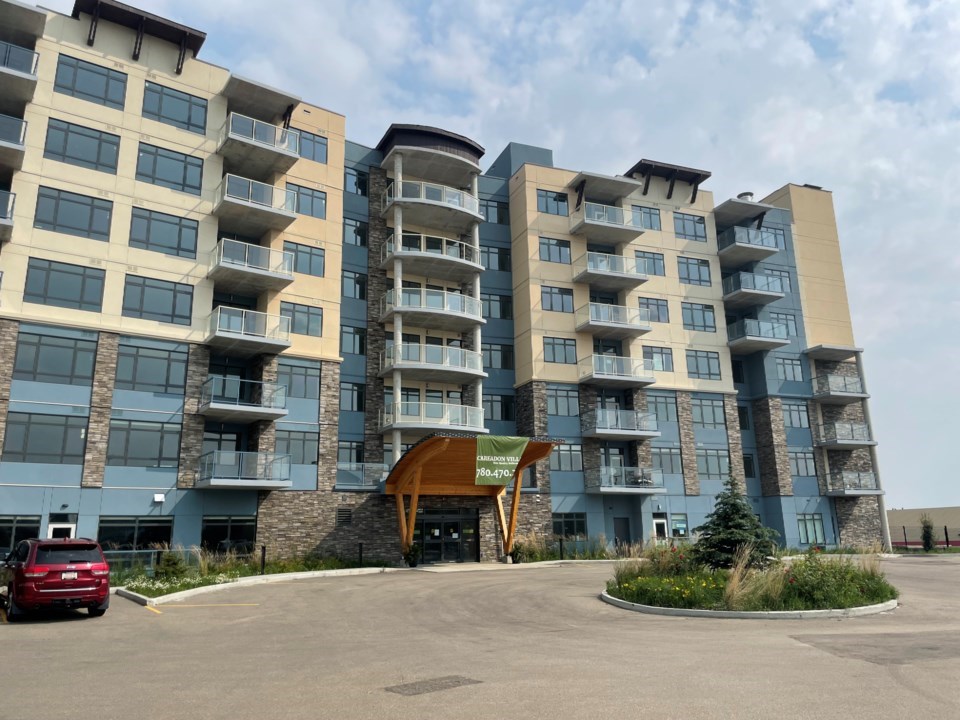There are roughly 2,300 rental units in some phase of development in St. Albert, according to the city, as the rental vacancy rate remains low, demand increases and prices sit at the second highest in the Edmonton region.
The average rent for an apartment in St. Albert in October 2023 was $1,447, a recent report from the Canada Mortgage and Housing Corporation (CMHC) shows. That was up $99 from October 2022. And it’s only $70 less than Strathcona County, the Edmonton region area with the highest average rental prices at $1,517 per month.
In the Edmonton region, rental vacancy rates dropped to 2.4 per cent in 2023 from 4.3 per cent in 2022, according to the report.
But in St. Albert, the rates are even lower. The rental vacancy rate for apartments is 2.2 per cent, while the rate for townhomes sits at one per cent, according 2023 year-end data from the city’s assessment and taxation department.
St. Albert currently has only 13 rental apartment buildings, which account for around 2,000 apartment units, and only two rental townhomes.
The number of rental apartments could nearly double soon.
Between major new developments such as Riverside and Midtown, which together are poised to add over 1,400 new units to the market, and smaller developments such as the proposed Homeland Housing project at 22 St. Thomas Street (118 units), the city says there are about 2,300 new rentals coming online.
Director of economic development Mike Erickson could not pinpoint exactly how many units would be completed by the end of 2024, but said it looks like “a strong year.”
“The last time we saw a set of strong years was back in 2014-15,” Erickson said.
The city aims “to provide diversity of products, so that people have choices relative to what they can afford and what they need at every stage of life,” he said.
Although some of the new developments are higher-end, luxury builds, Erickson said simply having more product available helps control the higher costs.
“If there's a shortage of supply, it's going to affect pricing for renters,” he said.
Rising rental prices
In 2023, Alberta’s rental prices, while still low in comparison to some cities in B.C. and Ontario, inflated faster than at any point in the past 40 years, according to Statistics Canada.
The CMHC report reveals that St. Albert’s apartment rental prices rose 6.8 per cent between October 2022 and October 2023. That’s slightly higher than the average for the Edmonton Census Metropolitan Area, which rose 6.3 per cent, but much lower than areas like Fort Saskatchewan and Stony Plain, which increased by 11.8 per cent and 12.6 per cent respectively.
January 2024 data from Rentals.ca and market research agency Urbanation suggest the picture of rising rents may have become even more alarming since October.
They found Edmonton’s prices have been growing at the fastest rate of any major Canadian city. In February, the average price for purpose-built and condo rentals reached $1,479. That’s a 17.1 per cent increase from the same time last year. St. Albert-specific data was unavailable.
“In St. Albert, the market is very tight for rentals,” said real estate agent Bob Maskell. “I have investors who own houses, and they're all full. I don't even know if anybody's got a vacancy right now.”
Maskell has clients, originally from St. Albert, who are selling their homes in other provinces and trying to move back to the city but can’t find anywhere to rent short-term.
“They’re all kind of just grabbing at what there is because there's so little inventory for rent or for sale,” he said. “It’s a dog’s breakfast.”
St. Albert has always had a tight rental market because so much of its housing inventory is occupied by homeowners, Maskell said. But the pickings are slimmer than he’s seen in some time, and what is available tends to move so fast potential renters can’t keep up.
Prices are also rising faster than many can afford.
“A lot of them are older seniors that don't have great pensions,” he said. “They get $1,500 a month … and they're going to get squeezed in the market because you no longer can rent for $700 or $800. It's now $1,000 to $1,400.”
“I have people tell me, ‘I have to spend on rent or food, you know? It's terrible.”




